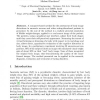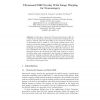MICCAI
2000
Springer
15 years 4 months ago
2000
Springer
MICCAI
2000
Springer
15 years 4 months ago
2000
Springer
A computer-based method for the assessment of body image distortions in anorexia nervosa and other eating-disordered patients is presented. At the core of the method is a realistic...
MICCAI
2000
Springer
15 years 4 months ago
2000
Springer
The needs of surgeons for computer-assisted systems cannot be satisfied unless their requirements and expectations are known. We determined surgeons' needs for computer-aided ...
163
click to vote
MICCAI
2000
Springer
15 years 4 months ago
2000
Springer
We present a novel approach to statistical shape analysis of anatomical structures based on small sample size learning techniques. The high complexity of shape models used in medic...
MICCAI
2000
Springer
15 years 4 months ago
2000
Springer
Performing a craniotomy will cause brain tissue to shift. As a result of the craniotomy, the accuracy of stereotactic localization techniques is reduced unless the brain shift can ...
MICCAI
2000
Springer
15 years 4 months ago
2000
Springer
Abstract. Fixation-based surgery is a new technique for achieving difficult corrections in some orthopedic procedures. The method is premised on using a fixation device, such as a ...
111
click to vote
MICCAI
2000
Springer
15 years 4 months ago
2000
Springer
In image-guided neurosurgery, "mixed reality" merging has been used to merge video images with an underlying computer model. We have developed methods to map intra-operat...
MICCAI
2000
Springer
15 years 4 months ago
2000
Springer
This paper presents a statistical approach to aggregating speed and phase (directional) information for vascular segmentation in phase contrast magnetic resonance angiograms (PC-MR...
MICCAI
2000
Springer
15 years 4 months ago
2000
Springer
A magnetic resonance (MR) compatible surgical assist robot system under preclinical evaluation is described. It is designed to coexist, and cooperate, with a surgeon, and to positi...
82
Voted
MICCAI
2000
Springer
15 years 4 months ago
2000
Springer
Abstract. An N-dimensional image is divided into "object" and "background" segments using a graph cut approach. A graph is formed by connecting all pairs of nei...


